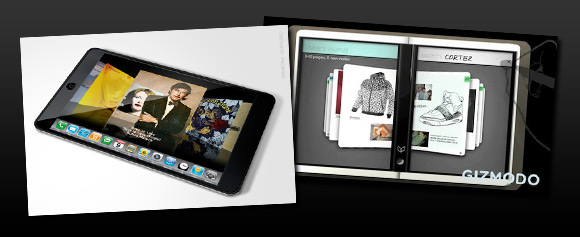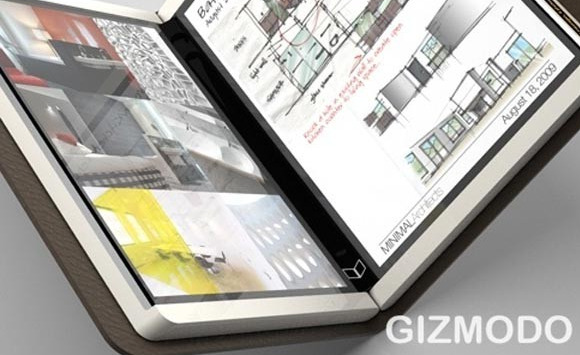
Ask yourself this: “What would I use a tablet for?” Regardless of the recent drama surrounding the Crunchpad’s untimely end – and the disappointing Fusion Garage Joojoo tablet taking its place – it seems that the entire tech industry is ready to embrace tablets with open arms. There’s the never-ending hype about the possible Apple tablet, Microsoft Research’s Courier project, and netbook companies like Asus announcing they’re developing tablets in the coming year. We’re also seeing articles predicting 2010 as the year of the tablet, and others espousing why tablets signal the end of netbooks.
But despite all the hype, (which I’ll admit adding to when I wrote this piece), I’ve yet to find a good explanation as to how, exactly, tablets will be of any great use to consumers, or how they’re a significant step forward for the technology industry. Don’t get me wrong, they could potentially become worthwhile at some point in the next few years – but that doesn’t seem to be happening anytime soon.
Instead, it seems like we’re being told we need tablets, more so than tablets are organically fulfilling any sort of consumer needs. What follows are several reasons why I think tablets have yet to prove their worth, and also what needs to happen for them to do so.
They need to be cheap, and we’re not seeing that yet
First and foremost, tablets need to be inexpensive to compete with the onslaught of other tech devices consumers are faced with. And by inexpensive, I mean ideally around $200 for mass adoption – though I could understand if the first run of devices were closer to $300 to cater to the early adopters. Judging by the Joojoo, which was announced with a way-too-high $500 price tag, things aren’t looking so good for inexpensive tablets. And given the little we know about the Apple tablet, it’s unlikely that it will retail below $500 either.
In the Joojoo’s defense, Fusion Garage is the closest to releasing an actual multi-touch tablet, which for the past few years has been mostly a thing of fantasy. They even had the foresight to include a dedicated graphics chip so the device can play some games and HD video. But then reality comes crashing in when we consider the device’s sad five hour battery life, and 1GB of RAM. Given the company’s legal troubles with TechCrunch head-honcho Michael Arrington, I won’t have much faith in the device until it’s actually shipping to those brave souls willing to give this company $500.
If Fusion Garage is still around in a year or so, Joojoo could easily become much cheaper. I also expect cheaper tablets to eventually come from the likes of Asus, the creator of the netbook, who recently announced that they’re building a 4- to 7-inch Eee tablet.
It’s unclear what these devices will offer users

Price isn’t the only consideration when introducing a new technology, it also has to do something worthwhile to convince people to actually use it. (Consider the backlash against Twitter among those who don’t quite understand its value.) In the buildup to the CrunchPad, Arrington kept pushing the idea that he just wanted a thin and portable tablet to view web content on his couch. But is that enough to spawn an entirely new computing segment? Why not just get a netbook? (More on that below)
Consider the introduction of the iPod, the iPhone, or, to a lesser extent, the Amazon Kindle, to the marketplace. They made consumers excited, because people could easily imagine what they could do with those products. It also helped that most of what consumers were imagining were also fairly unheard of without those devices. Tablets? Not so much.
One obvious use for tablets is the digital distribution of interactive magazines and newspapers. Consider them a step up from web pages; they could be viewed offline (but also tout web-enabled features), take advantage of multi-touch gestures, and potentially save a dying publishing industry. Basically, tablets would allow publishers to digitally recreate their content in new and innovative ways (Apple is rumored to be doing just this with their tablet). This is already happening somewhat with the Amazon “Kindle” and Barnes and Noble “Nook” e-readers, but those devices are a long way off from offering gorgeous color.
Netbooks and cheap ultraportable laptops are finally taking off
It also seems like a bad time to introduce tablets, because netbooks (and their more powerful younger siblings, the latest ultraportable laptops) are finally hitting prices low enough to convince even more mainstream consumers to pick one up as a secondary machine. And those waiting for netbooks to get more powerful now have many new options to choose from – like the HP Mini 311 – that feature nVidia’s Ion chipset.
I’m just not entirely convinced enough people will pay a premium for a tablet, when they could get capable netbooks for much less. Netbooks and ultraportables also offer the option of keyboards – we’ve yet to see how easy data input will be on these tablets. They’ll obviously offer on-screen keyboards, but I could easily see that being a turn-off for many. Perhaps we’ll see wireless input devices down the line?
Forget the large multi-touch screens, Microsoft’s Courier is the most compelling tablet thus far

The only company that seems to be doing something exciting with the concept of the tablet is, surprisingly enough, Microsoft. Their Courier device is more of a booklet than a tablet, but it offers the same basic functionality of having a large multi-touch screen.
Here’s how I described the Courier in a previous post:
While Apple’s potential tablet seems to be getting most of the hype, I’m personally more intrigued by Microsoft’s Courier project. Microsoft is working from a blank slate with Courier, and though it does remind me quite a bit of a Nintendo DS used in portrait mode, there are definite benefits to that configuration. Its dual screen nature would make it ideal for eBook reading, multitasking without switching windows, and far more portable (and potentially more rugged) than a large single screen.
The key difference here? Microsoft has actually developed an entirely new user interface paradigm to take advantage of the device’s dual screens. I can actually imagine owning a Courier for notetaking, e-book reading, and other functions. It’s also sort of a dream device for students. As I’ve said before, “It seems elegant, and most importantly, intuitive, which would be key to helping this device take off with non-techy folk.”
It’s the first of these tablet devices to attempt to be more than just a very big iPod Touch, and that’s something that should be applauded. Innovation is a strange thing to see coming out of Microsoft these days (outside of the Xbox 360 and Zune), but in the span of a few photos, and short videos, they’ve created a device that I can see myself wanting desperately.
The only problem with the Courier is that it’s far from production, and we don’t even know if it will make its way to stores in 2010. Still, at least we know it exists – unlike the Apple tablet.
Final thoughts
I don’t think I’m being too hard on tablets here. I’m just asking for device manufacturers to give us a reason to want these things. Considering that you could buy an Amazon Kindle, along with a netbook, for around $500, I see very little reason for anyone to shell out the same amount of money for an overall less capable tablet.
In the end, tablets will have to get cheaper and offer truly compelling content to sway consumers. Otherwise, they’ll just remain fantasy devices for the tech elite.
About the author:
Devindra Hardawar is a tech/film blogger and podcast host. You can find him writing at the Far Side of Tech and Slashfilm.


























